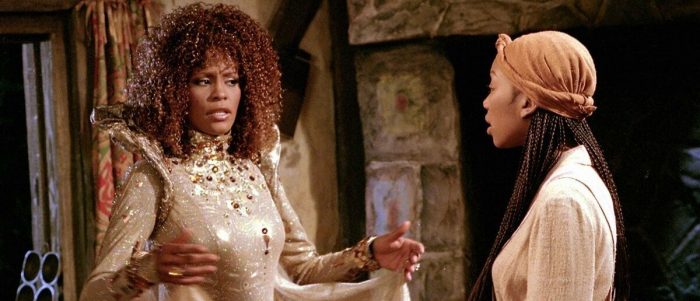
(Welcome to The Quarantine Stream, a series where the /Film team shares what they’ve been watching while social distancing during the COVID-19 pandemic.)
The Movie: Rodgers & Hammerstein’s Cinderella
Where You Can Stream It: Disney+
The Pitch: Co-produced by Whitney Houston, who also appears as Cinderella’s Fairy Godmother, the 1997 remake of the Rodgers & Hammerstein’s Cinderella TV musical features a “color-blind” cast led by a lovely Brandy, at the height of her R&B and acting career.
Why It’s Essential Quarantine Viewing: Because the world is full of zanies and fools who don’t believe that the Brandy Cinderella is a bonafide classic.
Rodgers & Hammerstein’s Cinderella is an unlikely ’90s classic. When it debuted on ABC in 1997, it was met with a chilly reception from critics, with the New York Times even calling it a “cobbled-together ‘Cinderella’ for the moment, not the ages.” But it’s accepted nowadays as one of the most beloved — if not the best — Cinderella screen adaptations by the millions of ’90s kids who uphold it as a formative part of their youths (this writer included).
Dubbed by its many fans as “the Brandy Cinderella,” the diverse take on the Rodgers & Hammerstein TV musical (initially written for television in 1957 with a young Julie Andrews starring, followed by a remake in 1965) is colorful in all meanings of the word. Before we even get to its gaudy-bright production and costume design that looked like they were made by someone who had just seen color for the first time, we have to talk about the “color-blind” cast, which was unmatched for its multicultural ensemble until Hamilton. R&B star Brandy was Cinderella, her prince was played by Filipino American actor Paolo Montalbán, who somehow had white and black parents played by Victor Garber and Whoopi Goldberg. Bernadette Peters eats up every line as Cinderella’s evil stepmother, while Jason Alexander puts on an inexplicable accent to play the prince’s foppish valet. And of course, there’s the indomitable Whitney Houston, who was the reason that this Cinderella came together, and gave us one of the most iconic moments in behind-the-scenes footage history:
in honor of “cinderella” being released to disney+ next friday, i just had to put this MOMENT back on the timeline pic.twitter.com/SklFjRk3Hr
— ??? ? (@ivyknowIes) February 4, 2021
Houston executive produced Cinderella and hand-picked Brandy for the lead — the first time the fairy tale princess was ever played by a Black actress, and a landmark that Houston would have to fight for. According to Kendra James’s oral history of the production, producers balked at casting a Black actress for Cinderella and a producer even suggested casting Jewel instead. But Brandy got the part, and the magic began.
Cinderella looks and feels like a TV movie (it’s a little cheap-looking, Brandy seems a bit lost at times, and the film just kind of ends after an extensive, but fun, montage), but there’s a degree of bombast from both the ensemble and the film’s production that makes it unforgettable. There’s the aforementioned Peters and Alexander, both putting on absurd, outsized performances that are only matched by the absurd costume and set design. Julie Kaye Fanton, Edward L. Rubin, and Randy Ser were responsible for the “bright and bold” color palette of the highly artificial-looking sets — which only added to the heightened fairy tale quality from director Robert Iscove, who described the film’s setting as “nouveau into deco.” This pastiche of clashing art elements create an almost aggressive visual style, which is only counterbalanced by the genuine sweetness of the musical — Rodgers and Hammerstein delivering as always — and its leads Brandy, Houston, and Montalbán. It’s a corny, messy musical extravaganza that lived up to the memories I had of it as a kid, playing on repeat on TV.
The post The Quarantine Stream: ‘Rodgers & Hammerstein’s Cinderella’ is an Impossibly Cheesy Delight appeared first on /Film.
0 Comments